‘What’s your purpose?’, is an online DIY programme enabling businesses to define their brand in-house, without the need to hire expensive external resource.
You’ll learn how to define your ‘Vision’, ‘Mission’, ‘Values’, ‘Proposition’, ‘Personality’, and ‘Reasons-to-believe’.
Written in plain English and broken into manageable steps, it is packed full of practical advice and tips. The first section explains brand theory simply, breaking down all the terms and demystifying the process. The following section walks you through the step-by-step guide explaining exactly what to do, how to do it and when to do it. Simple.
Expert brand definition at a fraction of the usual cost.
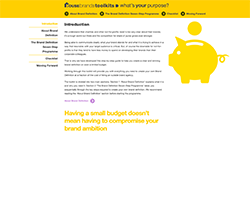
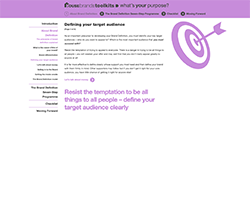
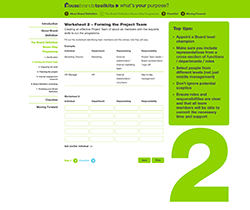
‘What’s your purpose?’, is an online DIY programme enabling businesses to define their brand in-house, without the need to hire expensive external resource.
You’ll learn how to define your ‘Vision’, ‘Mission’, ‘Values’, ‘Proposition’, ‘Personality’, and ‘Reasons-to-believe’.
Written in plain English and broken into manageable steps, it is packed full of practical advice and tips. The first section explains brand theory simply, breaking down all the terms and demystifying the process. The following section walks you through the step-by-step guide explaining exactly what to do, how to do it and when to do it. Simple.



Expert brand definition at a fraction of the usual cost.
The short answer is it is for all businesses, large and small, who are interested in the success of their brand. You may be a new, small company that is just launching and needs to build a brand from scratch, or a large well-established company in need of a brand refresh. No matter which, ‘What’s your purpose?’ can help ensure that you get the results you need.
You don’t even need to have any previous brand experience as the toolkit will walk you through the programme step-by-step, providing clear definitions for any technical terms.
If you are more experienced, the toolkit will provide you with a ready-made programme to follow, supported by top tips on:
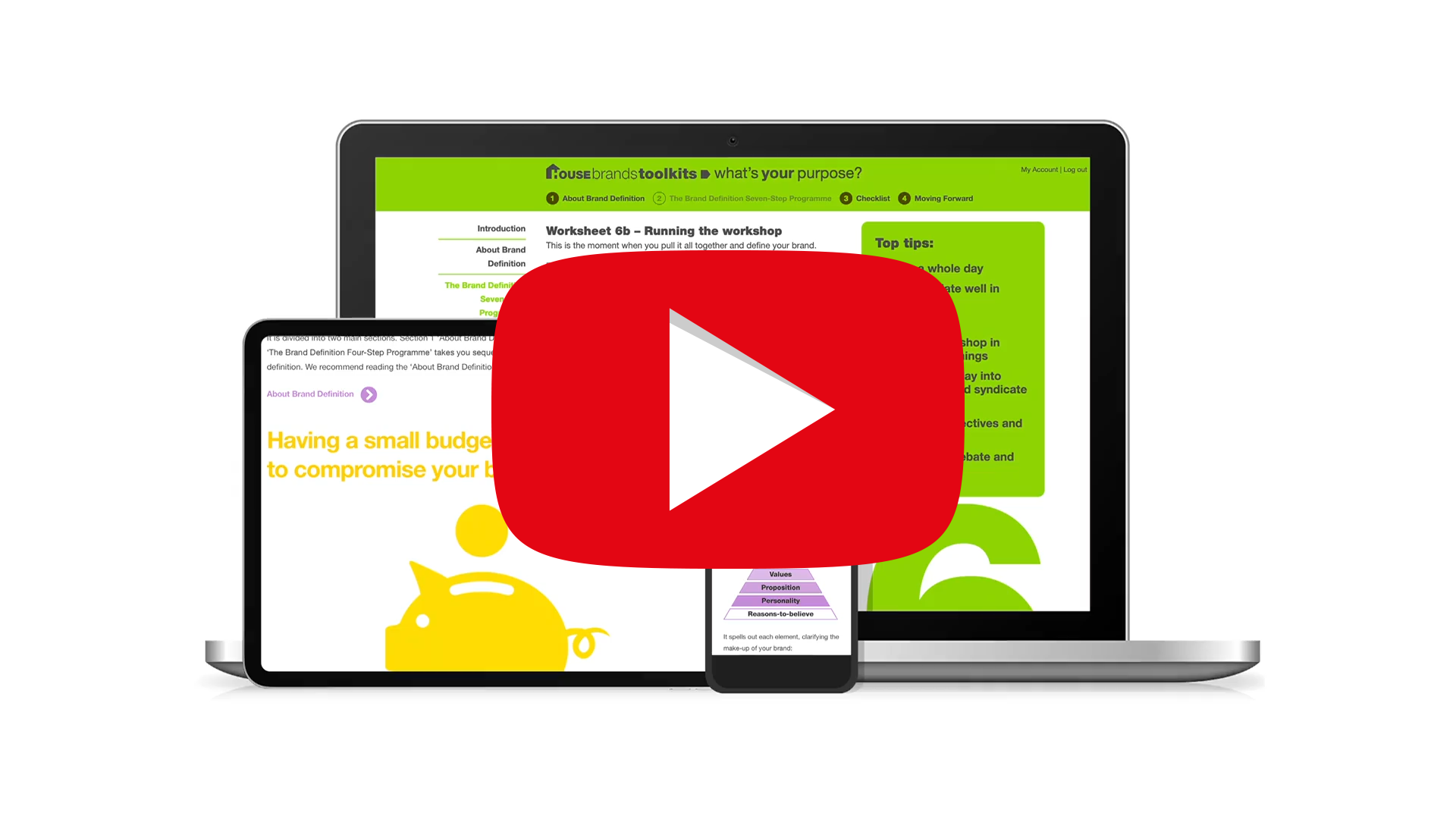
In short, the toolkit gives you everything you need to ensure that you create a truly effective brand definition.
Strong brands are clear about who they are and why they are different. No matter what sector you are in, you want your company to stand out from your competitors and attract a loyal band of staff and customers alike. This means taking control of your brand, defining it clearly and then using that definition to set the direction for all your brand communications and activity.
However, that comes at a cost – one that you may well feel you could do without. External consultants don’t come cheap and so many businesses end up putting brand development low down the list of financial priorities, leaving it for a day when money is more plentiful.
That is why we have developed this step-by-step guide allowing you to create your own clear and winning brand definition. The toolkit will take you through the whole brand definition process yourself, guiding you through the same steps that our experienced brand consultants take and at a fraction of the cost.
Put simply, the toolkit will deliver a clear brand definition that is unique to your organisation. This is important as the brand definition is the blueprint that will direct all your brand communication and activity so that you are building a coherent brand reputation more quickly and more thoroughly.
Ultimately it will save you precious resource – both time and money. It will help your brand be stronger, more effective and sustainable.
Some of the advantages a clear brand definition will bring include:
which will help you:
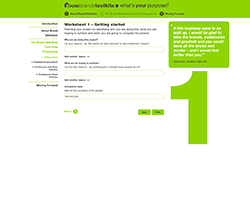
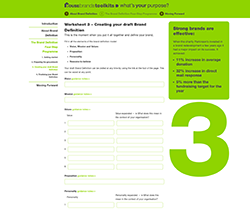
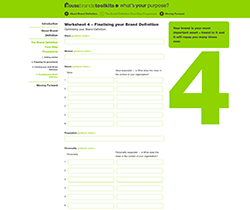
Professional brand development on a limited budget.
Put simply, the toolkit will deliver a clear brand definition that is unique to your organisation. This is important as the brand definition is the blueprint that will direct all your brand communication and activity so that you are building a coherent brand reputation more quickly and more thoroughly.
Ultimately it will save you precious resource – both time and money. It will help your brand be stronger, more effective and sustainable.
Some of the advantages a clear brand definition will bring include:
which will help you:




Professional brand development on a limited budget.
To succeed, your Brand Definition must be supported and endorsed by your people, whether they are full- or part-time employees. Stakeholder engagement is a crucial part of brand definition and particularly important in larger organisation. This is why ‘What’s your purpose?’ comes in two different versions – micro (for small organisations) and macro (for larger organisations) – see below.
All toolkits are sold using a six-month licence agreement, which is ample time to complete the project.
Our concise four-step programme provides smaller companies, including single person entities, with all they need to create their brand definition. It assumes that engaging the whole team is relatively straightforward and will not require a specific stakeholder engagement initiative.
At just £235 (+VAT) for a six-month licence, ‘What’s your purpose? – micro’ is perfect for smaller companies, who will benefit from defining their brand fully in-house.
Our more comprehensive seven-step programme is aimed at larger organisations (20+ employees) where the ultimate success of your brand relies on the support and engagement of all your people. The additional sections detail exactly how to run stakeholder engagement programmes and achieve the critical buy-in you need across your whole business, including the Board.
At just £895 (+VAT) for a six-month licence, the toolkit is a fraction of the cost of hiring outside resource.
The toolkit is divided into three sections:
Section 1: About Brand Definition
Explaining brand definition and introducing our own brand definition model – the one we use when defining our clients’ brands.
Section 2: The Brand Definition Four-Step Programme
The ‘how to’ guide to creating your own brand definition in-house. This section covers the programme, taking each step in turn, explaining what tasks need to be done and how to complete them. To help you, worksheets, templates and tips are provided with each step.
Section 3: Moving Forward
Defining your brand is the critical first step. But it is only the beginning of the journey. The next step is to make sure that it is embedded throughout your company and used to direct all your communications and activity. This section helps set you on the right road.
The programme explains:
The toolkit is divided into four sections:
Section 1: About Brand Definition
A comprehensive explanation of what brand definition is and an introduction to our own brand definition model – the one we use when defining our clients’ brands. As ‘What’s your purpose? – macro’ is aimed at larger organisations it provides more detail and rationale behind the need for defining your brand. It discusses and explains a number of important issues including:
Section 2: The Seven-Step Programme
Divided into clear stages, the programme covers:
To help you, worksheets, templates and tips are provided with each step.
Section 3: Checklist
An easy to use summary of the programme to help you cover all the pieces of work you need to do in the right order.
Section 4: Moving Forward
Defining your brand is the critical first step. But it is only the beginning of the journey. The next step is to make sure that it is embedded throughout your organisation and used to direct all your communications and activity. This section helps set you on the right road.